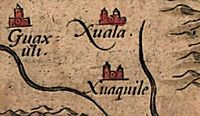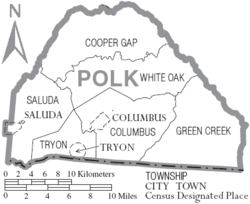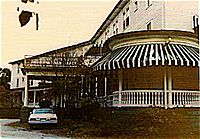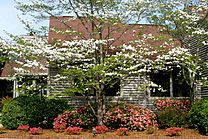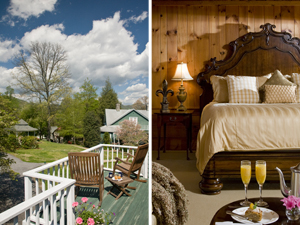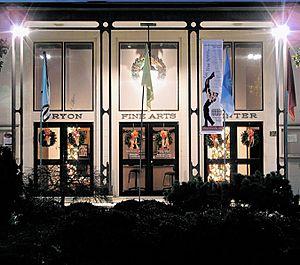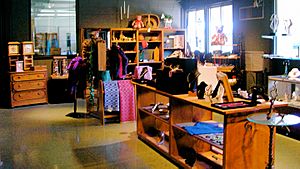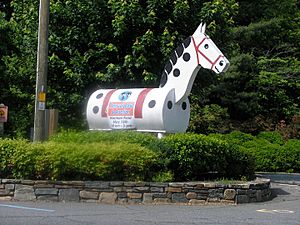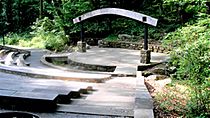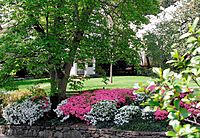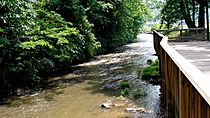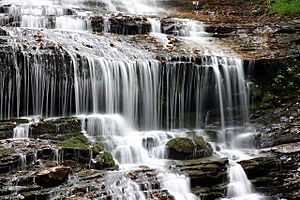Tryon, North Carolina facts for kids
Quick facts for kids
Tryon, North Carolina
|
||
|---|---|---|
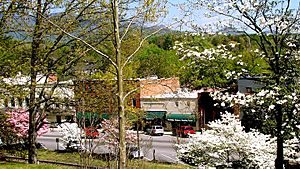
Trade Street, Tryon, North Carolina
|
||
|
||
| Motto(s):
"The Friendliest Town In The South"
|
||

Location of Tryon, North Carolina
|
||
| Country | United States | |
| state | North Carolina | |
| county | Polk | |
| Incorporated | 1885 | |
| Named for | William Tryon | |
| Area | ||
| • Total | 2.00 sq mi (5.17 km2) | |
| • Land | 2.00 sq mi (5.17 km2) | |
| • Water | 0.00 sq mi (0.00 km2) | |
| Elevation | 1,063 ft (324 m) | |
| Population
(2020)
|
||
| • Total | 1,562 | |
| • Density | 782.17/sq mi (301.94/km2) | |
| Time zone | UTC-5 (Eastern (EST)) | |
| • Summer (DST) | UTC-4 (EDT) | |
| ZIP code |
28782
|
|
| Area code(s) | 828 | |
| FIPS code | 37-68580 | |
| GNIS feature ID | 2406761 | |
| Website | tryon-nc.com | |
Tryon is a small town in Polk County, located in the southwestern part of North Carolina, United States. In 2020, about 1,562 people lived there. Tryon is nestled in the Blue Ridge Mountains. Today, it's known as a wealthy area that's great for outdoor activities, horse riding, and enjoying fine arts.
Both Tryon Peak and the town itself are named after William Tryon. He was the Governor of North Carolina from 1765 to 1771. He was honored for helping to make a peace treaty with the Cherokee people after the French and Indian War.
Contents
Exploring Tryon's Past: A Look at Its History
Who Lived Here First? The Cherokee People
The land where Tryon is now was originally a hunting ground for the Cherokee people in Western North Carolina. Scientists have found proof that people lived here over 11,000 years ago, right after the last ice age ended. Different groups of people lived in the river valleys over time.
Around 8,000 B.C., semi-permanent villages started to appear in the area. The Cherokee later built towns with a democratic government. They developed their own religion, grew crops, made pottery, and were skilled archers. They grew vegetables, hunted, and fished. Each Cherokee village had a peace chief, a war chief, and a priest.
When Spanish Explorers Arrived
A Spanish explorer named Hernando de Soto landed in Florida in May 1539. He is believed to have traveled north into western North Carolina. In May 1540, de Soto and about 1,000 men arrived in North Carolina, riding horses. They were looking for gold.
De Soto explored the area near Asheville and met the Cherokee in their village called Xuala. This is the area we know as Tryon today. After a couple of days, de Soto continued his journey. The Cherokee people gave him supplies for his travels.
One of de Soto's officers, Luys Hernandez de Biedma, wrote about their visit to Xuala on May 21, 1540:
The next day, they went to Xuala which is a town on a plain between some rivers; its chief was so well provisioned that he gave to the Christians however much they asked for: slaves, corn, little dogs [probably opossums]… and however much he had.
From Xuala, de Soto went to a place called Gauxuile, which is now Asheville. In Cherokee, this name meant "The place where they race."
Early English Settlers and Conflicts
When English settlers first arrived, they had peaceful relationships with the Cherokee. Most British colonists settled near the coast. A treaty signed in 1730 brought more white traders and settlers into Cherokee lands.
An old house called Seven Hearths was built in 1740. It is thought to be the oldest wooden house in the county. It was moved to its current spot in 1934. A log cabin, also built around 1740, was moved and rebuilt next to Seven Hearths in the 1930s.
The French and Indian War (a part of the Seven Years War) ended the peace between the Cherokee and the English. Both the French and English tried to get Native American groups to help them fight. The French were allies with the Creek people, who were rivals of the Cherokee. The French also tried to make friends with the Cherokee, who had traded with the British for a long time.
As tensions grew, the British built forts to protect their land. One of these was the "Block House" near where Tryon would later be. Conflicts with the Cherokee continued after Britain won the war. The Cherokee were trying to stop English colonists from taking their land.
In 1767, William Tryon, who was the governor from 1765 to 1771, came to the area. He worked out a peace treaty with the Cherokee. They set a boundary line from near Greenville, South Carolina to the top of White Oak Mountain. Settlers later renamed this mountain Tryon Peak. However, settlers did not always respect this boundary. When the American Revolutionary War started, some Cherokee hoped to push the white settlers off their lands.
In the spring of 1776, Cherokee leaders met on Round Mountain. They planned to attack the "Block House," Earl's Fort, and Young's Fort. A Cherokee man named Skyuka found out about these plans. He warned his friend, Captain Thomas Howard, at the "Block House." Howard and the local militia went to Round Mountain. They met and defeated the Cherokee at a valley gap, now called Howard Gap. Settlers honored Skyuka by naming Skyuka Creek, Skyuka Road, and the YMCA Camp Skyuka after him.
Tryon's Post Office and Early Names
In 1839, a post office was opened at the top of Howard Gap and Holberts Cove Roads. It was run by the Thompson Family and was named the Tryon Post Office. In early Polk County, what is now Saluda township was called Tryon township. The area that is now Tryon city was part of Columbus Township until Tryon city was officially created in 1885. Both were named after Governor Tryon.
Railroad and Welcoming Visitors
By 1877, the railroad offered regular travel from South Carolina seaports like Charleston, SC to North Carolina, Tennessee, and the Ohio Valley. The specific spot that became Tryon was where the railroad construction to Asheville stopped for two years. West of Tryon, the railroad goes up the Blue Ridge on the Saluda Grade. This was the steepest railroad grade in the country before it stopped being used.
Tryon became an official town in 1885, during a time when railroads were expanding a lot. By the 1890s, the railway made six stops in Tryon every day. The current train station building was built in 1922. It was the third station built there. When more people started using cars, passenger train service to Tryon ended in 1968.
Oak Hall was first built as the Tryon Hotel in 1881. It sits on a hill overlooking Trade Street. Many famous people stayed there, including Henry Ford, Thomas Edison, actor David Niven, writer F. Scott Fitzgerald, and composer George Gershwin. The hotel was turned into apartments in the early 2000s.
F. Scott Fitzgerald loved the ice cream at Misseldine's drug store. He even wrote a short poem about it:
Oh Misseldine's, dear Misseldine's,
A dive we'll ne'er forget,
The taste of its banana splits
Is on our tonsils yet.
Its chocolate fudge makes livers budge,
It's really too divine,
And as we reel, we'll give one squeal
For dear old Misseldine's.
Recent Events: Tropical Storm Helene
On September 27, 2024, Tropical Storm Helene caused a lot of damage in Tryon.
Tryon's Location and Weather
Where is Tryon Located?
The town's first boundary was a circle with a radius of three-quarters of a mile. The United States Census Bureau says the town covers about 1.8 square miles (4.6 square kilometers), and it's all land.
What is Tryon's Climate Like?
Tryon is near a "thermal belt." This is an area that usually doesn't get much dew or frost, making the weather pleasant all year. This mountain climate attracted many visitors and residents to Tryon, some of whom have second homes here. In this part of the Blue Ridge mountains, the air on the slopes can be warmer than in the valleys, especially in spring and fall. This means Tryon has longer periods of warm weather, which helps crops grow better. Tryon's climate is similar to other areas in the Piedmont region.
| Climate data for Tryon, North Carolina (1991–2020 normals, extremes 1917–present) | |||||||||||||
|---|---|---|---|---|---|---|---|---|---|---|---|---|---|
| Month | Jan | Feb | Mar | Apr | May | Jun | Jul | Aug | Sep | Oct | Nov | Dec | Year |
| Record high °F (°C) | 83 (28) |
83 (28) |
92 (33) |
95 (35) |
98 (37) |
105 (41) |
105 (41) |
103 (39) |
105 (41) |
96 (36) |
87 (31) |
82 (28) |
105 (41) |
| Mean daily maximum °F (°C) | 49.6 (9.8) |
53.7 (12.1) |
61.3 (16.3) |
70.2 (21.2) |
76.8 (24.9) |
83.2 (28.4) |
86.3 (30.2) |
84.7 (29.3) |
79.2 (26.2) |
70.3 (21.3) |
60.4 (15.8) |
52.0 (11.1) |
69.0 (20.6) |
| Daily mean °F (°C) | 40.8 (4.9) |
43.9 (6.6) |
50.8 (10.4) |
59.5 (15.3) |
67.0 (19.4) |
74.0 (23.3) |
77.5 (25.3) |
76.0 (24.4) |
70.5 (21.4) |
60.6 (15.9) |
50.8 (10.4) |
43.5 (6.4) |
59.6 (15.3) |
| Mean daily minimum °F (°C) | 31.9 (−0.1) |
34.1 (1.2) |
40.4 (4.7) |
48.8 (9.3) |
57.2 (14.0) |
64.9 (18.3) |
68.6 (20.3) |
67.3 (19.6) |
61.8 (16.6) |
50.9 (10.5) |
41.2 (5.1) |
35.0 (1.7) |
50.2 (10.1) |
| Record low °F (°C) | −8 (−22) |
2 (−17) |
10 (−12) |
18 (−8) |
29 (−2) |
38 (3) |
44 (7) |
46 (8) |
35 (2) |
23 (−5) |
8 (−13) |
0 (−18) |
−8 (−22) |
| Average precipitation inches (mm) | 5.32 (135) |
4.47 (114) |
5.52 (140) |
5.31 (135) |
5.34 (136) |
5.48 (139) |
5.55 (141) |
6.07 (154) |
5.63 (143) |
4.90 (124) |
4.80 (122) |
5.96 (151) |
64.35 (1,634) |
| Average snowfall inches (cm) | 2.4 (6.1) |
0.8 (2.0) |
0.6 (1.5) |
0.0 (0.0) |
0.0 (0.0) |
0.0 (0.0) |
0.0 (0.0) |
0.0 (0.0) |
0.0 (0.0) |
0.0 (0.0) |
0.0 (0.0) |
1.1 (2.8) |
4.9 (12) |
| Average precipitation days (≥ 0.01 in) | 11.4 | 10.3 | 11.7 | 10.7 | 12.0 | 13.4 | 13.4 | 13.3 | 10.0 | 8.8 | 9.0 | 11.1 | 135.1 |
| Average snowy days (≥ 0.1 in) | 1.0 | 0.5 | 0.4 | 0.0 | 0.0 | 0.0 | 0.0 | 0.0 | 0.0 | 0.0 | 0.0 | 0.5 | 2.4 |
| Source: NOAA | |||||||||||||
People and Community in Tryon
Tryon's Population Over Time
| Historical population | |||
|---|---|---|---|
| Census | Pop. | %± | |
| 1900 | 324 | — | |
| 1910 | 700 | 116.0% | |
| 1920 | 1,067 | 52.4% | |
| 1930 | 1,670 | 56.5% | |
| 1940 | 2,043 | 22.3% | |
| 1950 | 1,985 | −2.8% | |
| 1960 | 2,223 | 12.0% | |
| 1970 | 1,951 | −12.2% | |
| 1980 | 1,796 | −7.9% | |
| 1990 | 1,680 | −6.5% | |
| 2000 | 1,760 | 4.8% | |
| 2010 | 1,646 | −6.5% | |
| 2020 | 1,562 | −5.1% | |
| U.S. Decennial Census | |||
In 2020, Tryon had 1,562 residents. There were 823 households and 280 families living in the town.
Different Cultures in Tryon
| Race | Number | Percentage |
|---|---|---|
| White (not Hispanic) | 1,207 | 77.27% |
| Black or African American (not Hispanic) | 190 | 12.16% |
| Native American | 3 | 0.19% |
| Asian | 7 | 0.45% |
| Other/Mixed | 94 | 6.02% |
| Hispanic or Latino | 61 | 3.91% |
Places of Worship in Tryon
Tryon has many churches for different faiths. These include Grace Foothills Church, Tryon Presbyterian Church, Holy Cross Church & Chapel (Episcopal), Congregational Church, St. John the Baptist Catholic Church, First Baptist Church, Tryon United Methodist Church, and Trinity Lutheran Church. Garrison Chapel Baptist Church is also in the area.
The Good Shepherd Episcopal Church was originally a chapel for enslaved African Americans. It was moved to Tryon in 1955. Its African-American congregation still uses its original furniture and glass.
Tryon's Economy and Tourism
Farming in Tryon
The sunny hillsides in Tryon are great for growing fruit trees and grapes for wine. Vineyards were started in the Pacolet Valley and other Tryon spots. By the 1950s, the grape industry faced problems because fewer people used trains and there was more competition from California grapes. However, growing grapes is making a comeback in the area. Since the 1990s, several new vineyards have opened around Tryon.
Visiting Tryon: A Popular Tourist Spot
Tryon has always been a popular place for tourists, especially for writers and artists looking for a peaceful retreat.
The Pine Crest Inn was built in 1906 as a sanitarium for people with tuberculosis (TB). Before penicillin was discovered, resting in mountain air was thought to help treat TB. In 1917, the sanitarium became an inn. Hunters liked the inn because it was close to good hunting areas. A very old cabin, Swayback cabin, hosted famous American writers Ernest Hemingway and F. Scott Fitzgerald.
The inn was added to the National Register of Historic Places in 1982. Its dining room is highly rated.
Tryon is also well-known for horse-related tourism. The U.S. Olympic Equestrian team has even trained here. In 2018, Tryon hosted the FEI World Equestrian Games, which is like the "Horse Olympics." This event brought hundreds of thousands of visitors to the area.
Culture and Activities in Tryon
Arts and Creativity in Tryon
- The Tryon Fine Arts Center
The Tryon Fine Arts Center is on Melrose Avenue. It's a place for visual and performing arts, offering music, plays, movies, and other cultural events. It started in 1969 and also offers art classes. The center's theater can seat 345 people and has a system for those who are hard of hearing.
Groups like the Tryon Painters and Sculptors and the Carolina Photo Club use the center. The Photo Club shows their photos every January and February. They also have an annual photo contest, and the winning pictures are displayed at the center.
- Tryon Arts and Crafts School
The Tryon Arts and Crafts School opened in 1960. It helps people learn and express themselves through traditional and modern arts and crafts. In the 1950s, local artists let people learn crafts in their homes. A big snowstorm in 1959 inspired the idea for a formal organization. Grace Hall, a local resident, was stuck at home for three weeks. She wrote to the Tryon Daily Bulletin suggesting a local crafts center. Many people agreed, including architect Carter Brown and Violet Parish-Watson.
In April 1960, 200 local residents paid a one-dollar membership fee to start Tryon Crafts, Inc. Local artists began selling their work and teaching classes. The school, now called Tryon Arts & Crafts, is located at 373 Harmon Field Road. It has professional studios for many arts, like fiber arts, pottery, jewelry, lapidary, woodworking, multimedia, and blacksmithing.
- Tryon Concert Association
The Tryon Concert Association has brought "world-class artists" to Tryon since 1955. Their first concert featured baritone Robert McFerrin. Soon after, McFerrin became the first African American to join the Metropolitan Opera Company in New York City. The association hosts four high-quality concerts each year from fall to spring.
- Tryon Little Theater
The Tryon Little Theater has been a big part of the community since 1948. They put on four plays a year and offer classes and workshops. Anyone can try out for their plays. They also help produce the Tryon Summer Youth Theater for ages 12–18.
- Tryon Youth Center
The Tryon Youth Center is a 5,300 square foot (492 square meter) building on US Highway 176. It offers art, social, and fun programs for young people. Each summer, they produce a musical at the Tryon Fine Arts Center.
- Children's Theatre Festival
The Children's Theater Festival started in 1978. It brings "lively arts" for children, including 8 to 10 different performances. These can be theater, music, storytelling, mime, dance, puppetry, and more. They happen on a Saturday in late March.
- Nina Simone's Birthplace
Tryon is the birthplace of the famous singer and piano player Nina Simone. Four African-American artists bought her childhood home to save it. The home has been named a national treasure. In downtown Tryon, there is a bronze sculpture of Nina Simone by Zenos Frudakis.
Tryon's Horse Community
Colonel Charles C. Ross, a local historian, once said, "The horse is all important in Polk County. Horses provide sport, pleasure, entertainment, business, and the good country living. It can be said that horses are a way of life in our pleasant community here in rural North Carolina."
In 1917, Carter Brown came to Tryon and opened the Pine Crest Inn. He made it a resort for wealthy people from the North. They could come to ride horses or play golf in the winter. In 1925, Brown started the Tryon Riding and Hunt Club. He also helped organize the Tryon Horse Show and the Block House Steeplechase in 1929 and 1934.
The Tryon Horse Show was once so popular that schools closed and most businesses shut down for the afternoon. The Tryon Horse Shows are now held at the Foothills Equestrian Nature Center (FENCE). In 1956, the U.S. Equestrian Team trained in Tryon for the Olympics. The Tryon Horse Show is still held today. It is the third oldest horse show and a recognized event by the United States Equestrian Federation.
Smaller horse shows happen at Harmon Field. Many local groups, like the Carolina Carriage Club and the River Valley Pony Club, also hold events.
Morris, the Tryon Horse, stands in the center of Tryon. He is a giant version of toys made by the Tryon Toymakers and Woodcarvers. The Tryon Riding and Hunt Club ordered the first Tryon Horse in 1928. The current Morris is the fifth one. Three earlier versions were lost to fire, being stolen, or old age. The fourth was updated with a fiberglass body. Morris acts as a billboard during the Tryon Horse Show and Steeplechase Races. At Christmas, he is decorated with garland and a top hat.
In May 2012, volunteers, the Town of Tryon, and the Tryon Daily Bulletin (known as "The World's Smallest Daily Newspaper!") worked together to raise money to fix Morris, who was getting old. The huge statue was "kidnapped" one night in June 2012 and held for "ransom." The newly fixed Morris was returned to his spot in November 2012.
- Tryon International Equestrian Center (TIEC)
In June 2014, the Tryon International Equestrian Center (TIEC) and Resort opened. It cost $100 million. It hosts many international horse competitions. Located near Tryon in Mill Spring, this 1,400-acre facility has up to 10 riding arenas, 1,000 permanent horse stalls, and a large covered riding area.
The Tryon Sports Complex at TIEC has a health club, game room, kids' camp, sports bar, playground, tennis courts, mountain bike park, climbing walls, basketball court, and a large pool. A 150-room hotel overlooks the equestrian center. The TIEC hosted the 2018 World Equestrian Games.
- Foothills Equestrian Nature Center (FENCE)
The Foothills Equestrian Nature Center (FENCE) is a 380-acre (1.5 square kilometer) nature preserve. It has trails for hiking, horse riding, and bird-watching. The center also has picnic areas and a pond. It hosts horse events and live concerts.
Libraries in Tryon
The Lanier Library Association is named after the poet Sidney Lanier. He lived in "the Wilcox house" in Lynn, three miles (5 km) north of Tryon. He died there on September 7, 1881. The house is now known as the "Lanier House."
In 1889, five women from Tryon decided to create a library. They wanted to offer "intellectual and cultural stimulation for the community." They first offered library membership to local women. The first books were two volumes of Sidney Lanier's poems, given by his wife, Mary. The library's books were kept in different places in town until the Lanier Library building was built in 1905. It has been expanded over the years. In 1930, the library started a fund to help pay for its operations. It also started allowing men to become members. The Lanier Library Association, Inc., provides library services and cultural programs. It is one of only a few membership libraries in the country, supported by dues, donations, and special funds.
Fun and Recreation in Tryon
The area is famous for its beautiful drives. You can see well-kept horse farms, thick forests, and rolling hills covered in kudzu.
Parks to Explore
Tryon has several parks, including:
- Rogers Park: Located downtown, this park has an outdoor amphitheater. It features a small creek and trails. The landscaping includes native plants and stone walls. It's used for public events like music shows and can be rented for private events like weddings.
- Greene Corner: On Melrose Avenue, across from the Tryon Fine Arts Center, this park has a lovely garden and gazebo. It's often used for photos.
- Sassoon Park: Also on Melrose Avenue, this park has a modern sculpture and green spaces.
- Harmon Field: This 46-acre (18.6 hectare) park is located on Harmon Field Road. It offers many activities for residents and visitors:
- It hosts horse events, with four horse rings and 140 stalls.
- There are two baseball fields, two soccer fields, four tennis courts, basketball courts, a dog park, trails, a disc golf course, and a playground.
- You can find shelters and grills for picnics.
- The field also has rental facilities and a snack stand.
Beautiful Scenic Drives
- Pacolet Scenic Byway: This is a ten-mile (16 km) part of US 176 that goes from Tryon to Saluda. It offers great views of the Pacolet River and its waterfalls.
- Pearson's Falls Natural Heritage Site: This site is known for its 90-foot (27 meter) waterfall. The Tryon Garden Club owns and maintains it. Located between Tryon and Saluda, it has a picnic area and trails for hiking and biking. A short walk from the entrance on US 176 leads to the waterfall. This "botanical preserve" has over 200 types of wildflowers and plants. It is a deciduous climax forest, meaning its trees are mature and stable. The falls were named after Charles William Pearson, an engineer who surveyed the Blue Ridge Mountains for the Norfolk Southern Railroad.
Getting Around Tryon
Tryon is located west of Interstate 26. This highway goes northwest to Asheville and southeast to Spartanburg, South Carolina. Tryon is about one mile from the North Carolina/South Carolina border. U.S. Highway 176 runs through the center of town, where it is called Trade Street.
Famous People from Tryon
- George Charles Aid (1872–1938), an American painter.
- Katharine Alexander (1898–1981), an actress who died in Tryon.
- Margaret Culkin Banning (1891–1982), a writer whose home, "Friendly Hills," is a historic place.
- William Behrends (born 1946), an American sculptor.
- Cathy Smith Bowers (born 1949), a poet and professor, and North Carolina Poet Laureate from 2010–2012.
- Crystal R. Fox (born 1964), an actress.
- Henry Jacques Garrigues (1831–1913), a Danish-born doctor who brought modern antiseptic methods to childbirth in the U.S.
- William Gillette (1853–1937), the actor famous for playing Sherlock Holmes. He built a home in Tryon.
- Mary Alice Monroe, an author.
- Richard Christian Nelson (born 1961), an artist.
- Mark Schweizer (1956–2019), a singer, composer, conductor, author, and publisher. He founded St. James Music Press.
- Nina Simone (1933–2003), a world-famous singer, pianist, composer, and activist.
- Amelia Van Buren (1856–1942), a photographer.
See also
 In Spanish: Tryon (Carolina del Norte) para niños
In Spanish: Tryon (Carolina del Norte) para niños




